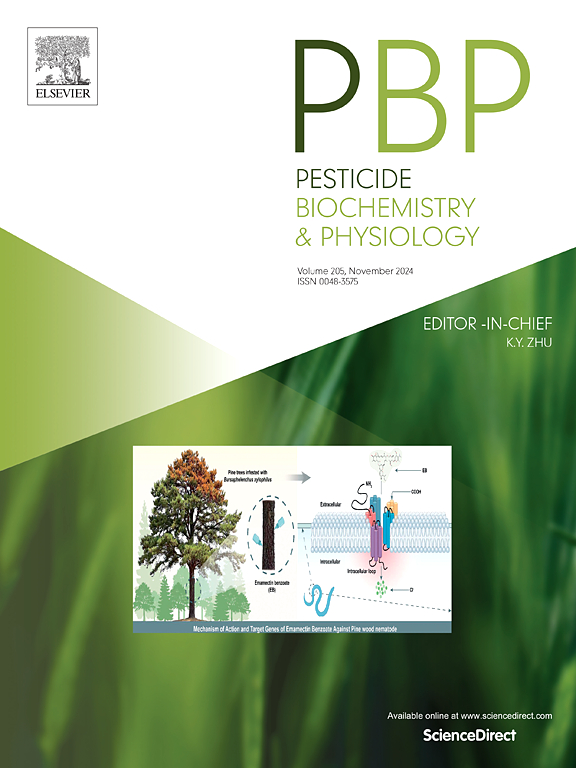海藻糖-6-磷酸合成酶和海藻糖酶基因的RNA干扰揭示海藻糖在中国褐球菌中的生理作用
IF 4.2
1区 农林科学
Q2 BIOCHEMISTRY & MOLECULAR BIOLOGY
引用次数: 0
摘要
海藻糖在昆虫的能量代谢和胁迫耐受中起着至关重要的作用。因此,我们采用RNA干扰的方法研究了海藻糖代谢基因海藻糖-6-磷酸合成酶(TPS)、可溶性海藻糖酶(Tre1)和膜结合海藻糖酶(Tre2)在美国褐球菌中的生理功能。注射后72 h, TPS、Tre1和Tre2基因的沉默效率分别为51.77%、71.38%和52.01%。沉默TPS会增加食物摄入量、体重、延长发育时间、降低葡萄糖、海藻糖和糖原水平以及蛹体重。相比之下,沉默Tre1和Tre2降低了摄取量、体重、葡萄糖和糖原水平以及蛹体重,延迟了发育,增加了海藻糖含量。沉默TPS、Tre1和Tre2会导致异常表型,如蛹和翅膀畸形。沉默TPS抑制了5个几丁质生物合成途径基因和2个脂质分解代谢相关基因的表达。TPS RNAi后,脂质生物合成相关的两个基因表达水平上调,Tre1和Tre2显著下调,而UAP和CHSA表达水平受TPS和Tre1 RNAi的特异性影响。沉默TPS、Tre1和Tre2基因可显著降低成年雌瓢虫的受精卵数量、产卵量和卵孵化率。总的来说,沉默TPS、Tre1和Tre2基因会破坏海藻糖代谢,影响海蝇的生长、发育和繁殖。这些发现强调了靶向海藻糖代谢基因作为一种环境友好型害虫管理策略的潜力。本文章由计算机程序翻译,如有差异,请以英文原文为准。

Physiological roles of trehalose in Hyphantria cunea revealed by RNA interference of trehalose-6-phosphate synthase and trehalase genes
Trehalose plays a crucial role in insect energy metabolism and stress tolerance. Therefore, we investigated the physiological functions of trehalose metabolism genes, namely trehalose-6-phosphate synthase (TPS), soluble trehalase (Tre1), and membrane-bound trehalase (Tre2) were investigated in Hyphantria cunea using RNA interference. Silencing of TPS, Tre1, and Tre2 genes achieved silencing efficiencies of 51.77, 71.38 and 52.01 %, respectively, at 72 h post-injection. Silencing TPS increased food intake, body weight, prolonged development duration, and decreased glucose, trehalose, and glycogen levels, and pupal weight. In contrast, silencing Tre1 and Tre2 decreased food intake, body weight, glucose and glycogen levels, and pupal weight, delayed development, and increased trehalose content. Silencing TPS, Tre1, and Tre2 caused abnormal phenotypes, such as pupal and wing deformities. Silencing TPS suppressed the expression of five genes in the chitin biosynthesis pathway and two to lipid catabolism related genes. The expression levels of two genes associated with lipid biosynthesis were upregulated, and as Tre1 and Tre2 were significantly downregulated after TPS RNAi, while UAP and CHSA expression levels were specifically affected by RNAi of TPS and Tre1. In female H. cunea adults, silencing TPS, Tre1, and Tre2 genes significantly reduced the number of eggs conceived, and laid and egg hatchability. Overall, silencing TPS, Tre1, and Tre2 genes disrupted trehalose metabolism, affecting the growth, development, and reproduction of H. cunea. These findings highlight the potential for targeting trehalose metabolism genes as an environmentally friendly pest management strategy.
求助全文
通过发布文献求助,成功后即可免费获取论文全文。
去求助
来源期刊
CiteScore
7.00
自引率
8.50%
发文量
238
审稿时长
4.2 months
期刊介绍:
Pesticide Biochemistry and Physiology publishes original scientific articles pertaining to the mode of action of plant protection agents such as insecticides, fungicides, herbicides, and similar compounds, including nonlethal pest control agents, biosynthesis of pheromones, hormones, and plant resistance agents. Manuscripts may include a biochemical, physiological, or molecular study for an understanding of comparative toxicology or selective toxicity of both target and nontarget organisms. Particular interest will be given to studies on the molecular biology of pest control, toxicology, and pesticide resistance.
Research Areas Emphasized Include the Biochemistry and Physiology of:
• Comparative toxicity
• Mode of action
• Pathophysiology
• Plant growth regulators
• Resistance
• Other effects of pesticides on both parasites and hosts.

 求助内容:
求助内容: 应助结果提醒方式:
应助结果提醒方式:


